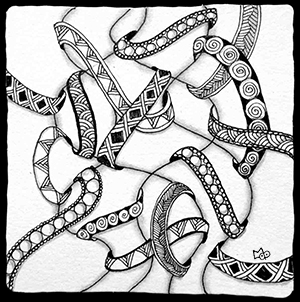

I discovered the technique of Zentwining as I was working on the drawings for the fronts of the Tangle Deck cards. I needed a drawing for the tangle Onomato. I picked up a piece of paper that I had drawn some random overlapping curved pencil lines on and began to draw ribbons wrapping around the lines. I then filled each ribbon with a variation of Onomato. I really liked the result and thought “this could be a technique that could be repeated easily.” I decided to share it and call the technique Zentwining.
1. The first step is to draw some overlapping curving pencil lines as in the following examples.
2. Next start drawing in ribbons that wrap around these lines. The ribbons are drawn in a similar way to the technique used in the tangle Aquafleur. I’ve used both re-curve and c-curve versions as shown below.
Here is an example.
3. Ribbons can go in any direction, extend off the page, and even cross lines. Using the Hollibaugh method of drawing behind makes it even more interesting.
4. Once you are satisfied with the quantity and placing of your ribbons, the next step is to draw over the pencil lines with pen making sure you stop at the edge of each ribbon and then start up again on the other side. Here is an enlargement so you can see what I mean.
Here is the drawing with all the lines drawn in pen except where the ribbons cross.
5. Now start adding tangles to the ribbons. You can use variations of one tangle as I did for the Onomato card or use different tangles.
As you can see, any remaining pencil lines are beginning to disappear into the tangles.
6. The final step is to add shading. I add shading to the tangles themselves first, then I add just a touch of shading to each side of the string lines to add a little 3D effect (makes the shapes formed by the strings kind of puffy.) Lastly I add shading to the ribbon shapes if I think it needs it.
Here are a couple of finished examples.
I will admit that this technique can take some concentration as it can get kind of busy as you work on it. Just take it slowly and be aware of your strokes and you’ll do fine. Hope you have fun playing with this technique and I look forward to seeing what you come up with.
Lynn Mead, CZT










